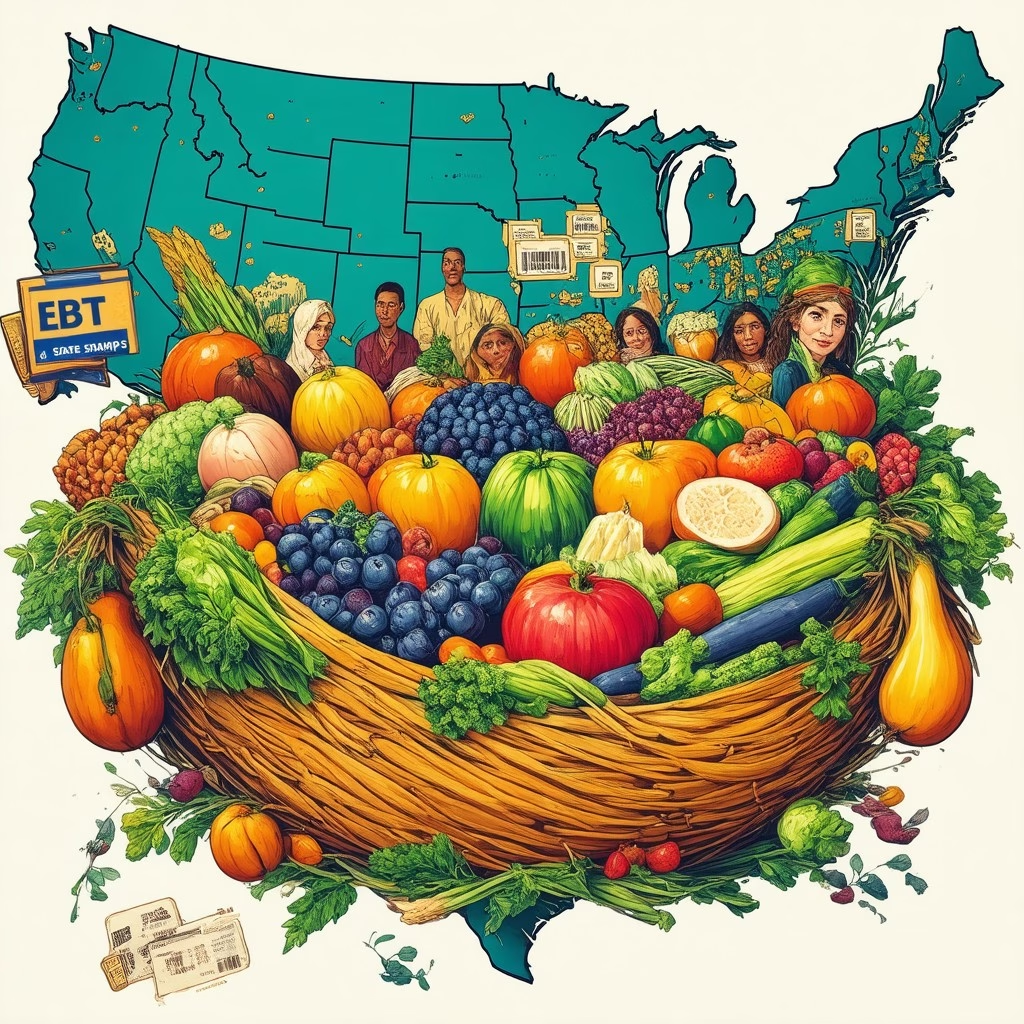Key Takeaways
- Understand the eligibility requirements for food stamp benefits, including income limits and residency status.
- Apply for food stamps online or in-person through your state’s SNAP portal for a streamlined process.
- Gather necessary documentation, such as proof of income and identification, to expedite your SNAP application.
- Explore resources like Gov Guider for guidance on application procedures and eligibility criteria.
- Learn about common misconceptions regarding SNAP benefits to better navigate the application process.
Are you looking to apply for food stamp benefits but unsure where to start? Navigating the SNAP program application can be overwhelming, especially with varying requirements and income limits across different states. In this comprehensive guide, we will break down everything you need to know about the food stamps application process, including eligibility criteria, income limits, and the step-by-step procedures for applying in states like Idaho, South Dakota, and Missouri. We will also address common questions such as, “Are food stamps based on income only?” and explore special considerations for seniors and homeowners. By the end of this article, you will have a clear understanding of how to apply for food stamps effectively and utilize available resources to manage your benefits. Let’s dive in and empower you with the knowledge to secure the assistance you need!
What are the requirements to receive food stamps in Idaho?
Overview of Food Stamp Requirements
To qualify for food stamps in Idaho, also known as the Supplemental Nutrition Assistance Program (SNAP), households must meet several specific eligibility requirements:
1. **Citizenship Status**: Applicants must be U.S. citizens or legal immigrants. Non-citizens may qualify under certain conditions, but documentation is required.
2. **Residency**: You must be a resident of Idaho. Proof of residency may be required during the application process.
3. **Income Limits**: Your household income must fall below the established income limits for your household size. As of 2023, the gross monthly income limit is typically 130% of the federal poverty level, which varies based on household size. For example, a household of four must have a gross income of less than approximately $2,839 per month.
4. **Work Requirements**: Most able-bodied adults aged 18-49 must either work a minimum of 20 hours per week or participate in an employment and training program. There are exceptions for individuals with disabilities, caretakers of young children, and certain other circumstances.
5. **Asset Limits**: Households may also need to meet asset limits, which generally should not exceed $2,250 for most households or $3,500 for households with a member aged 60 or older or disabled.
For more detailed information and assistance, applicants can visit the Idaho Department of Health and Welfare website or utilize resources like Gov Guider, which can help navigate the application process and provide additional support.
Eligibility Criteria for SNAP Benefits
Understanding the eligibility criteria for SNAP benefits is crucial for potential applicants. Here are the key factors that determine eligibility:
– **Household Composition**: The size and composition of your household play a significant role in determining eligibility and benefit amounts. Each member of the household is considered when calculating income limits.
– **Income Verification**: Applicants must provide documentation of their income, including wages, benefits, and any other sources of income. This verification is essential to ensure compliance with the income limits set by the SNAP program.
– **Employment Status**: Employment status is a critical factor. Individuals who are unemployed or underemployed may need to demonstrate their efforts to seek work or participate in training programs.
– **Special Circumstances**: Certain individuals, such as those with disabilities or elderly members, may have different eligibility criteria or exemptions from standard requirements.
For further insights into SNAP benefits and eligibility, you can explore resources like the [U.S. Department of Agriculture SNAP Program](https://www.fns.usda.gov/snap/supplemental-nutrition-assistance-program) and [Gov Guider’s comprehensive guide](https://govguider.com/understanding-the-snap-government-program-eligibility-benefits-and-impact-of-potential-shutdowns-on-food-stamps/) on SNAP benefits.

How to Apply for EBT South Dakota?
Step-by-Step Guide to EBT Application in South Dakota
To apply for the Electronic Benefits Transfer (EBT) program in South Dakota, follow these steps:
1. **Online Application**: The quickest way to apply for the Supplemental Nutrition Assistance Program (SNAP) is through the South Dakota EAP portal at eaportal.sd.gov. This online application allows you to fill out your information and submit it directly.
2. **In-Person Application**: You can also apply by visiting your local Social Services office. This option is beneficial if you need assistance or have questions during the application process.
3. **Downloadable Application**: If you prefer a paper application, you can download the application form from the South Dakota Department of Social Services website. After completing the form, return it either in person or via mail to your local Social Services office.
4. **Required Verification**: Be prepared to provide necessary verification documents, such as proof of income, residency, and identification. A complete list of required documents can be found on the South Dakota Department of Social Services website.
5. **Additional Resources**: For more detailed information and assistance, you can visit the South Dakota Department of Social Services SNAP page or contact their office directly.
For further guidance, consider using resources like Gov Guider, which can help navigate the application process effectively.
Online Resources for South Dakota EBT Application
When applying for EBT in South Dakota, several online resources can streamline the process:
– **South Dakota Department of Social Services**: Their official website provides comprehensive information about the SNAP program, including eligibility requirements and application procedures. Visit their site for updates and resources.
– **Gov Guider**: This platform offers detailed guides on how to apply for food stamps and navigate the SNAP program application. It’s a valuable resource for understanding your rights and the benefits available to you.
– **Benefits.gov**: This site can help you find information about food stamp benefits and other assistance programs. It’s a great starting point for understanding what you may qualify for.
Utilizing these online resources can simplify your application process and ensure you have the necessary information to apply for EBT successfully.
How to Qualify for EBT in Missouri
To qualify for the Supplemental Nutrition Assistance Program (SNAP), commonly known as EBT, in Missouri, you must meet specific eligibility criteria. Understanding these requirements is crucial for a successful SNAP program application. Here are the key factors to consider:
- Residency: You must be a resident of Missouri.
- Social Security Number: All household members must have a Social Security Number or agree to apply for one.
- Income Limits: Your household income must not exceed the current federal income limits. For example, as of 2023, a household of one can earn no more than $1,473 per month, while a household of four has a limit of $3,106 per month. These limits are subject to change, so it’s essential to check the latest guidelines.
- Resource Limits: Your household must not own more than $3,000 in countable resources, such as cash or bank accounts. If at least one member of your household is over the age of 60 or is disabled, the resource limit increases to $4,500.
- Work Requirements: Able-bodied adults without dependents (ABAWDs) must meet specific work requirements, including working at least 20 hours per week or participating in a qualifying work program.
For more detailed information and to apply, you can visit the Missouri Department of Social Services website or use the Gov Guider tool, which provides guidance on eligibility and application processes. Always refer to official resources to ensure you have the most current information regarding SNAP eligibility.
Common Misconceptions About EBT Eligibility
Many individuals have misconceptions about the eligibility criteria for EBT benefits in Missouri. Here are some common myths debunked:
- Myth 1: You must be unemployed to qualify for food stamps.
Reality: Employment status does not disqualify you. As long as your income meets the limits, you can qualify. - Myth 2: Only families with children can receive SNAP benefits.
Reality: Individuals and households without children can also qualify based on income and resource limits. - Myth 3: You cannot own a car and receive food stamps.
Reality: While there are resource limits, certain vehicles are exempt from being counted as resources. - Myth 4: You cannot receive benefits if you have savings.
Reality: As long as your countable resources are below the limit, savings do not automatically disqualify you.
Understanding these misconceptions can help you navigate the food stamp application process more effectively and ensure you have access to the benefits you may be entitled to.
What is the income limit for food stamps in WA?
The income limit for food stamps, officially known as the Supplemental Nutrition Assistance Program (SNAP), in Washington State varies based on household size and is updated annually. As of 2023, the following income limits apply:
- Household Size:
- 1 person: $1,473 per month
- 2 people: $1,984 per month
- 3 people: $2,495 per month
- 4 people: $3,006 per month
- For each additional person, add approximately $511.
Eligibility Criteria: Households must meet both gross and net income limits. The gross income limit is typically set at 130% of the federal poverty level, while the net income limit is 100% of the federal poverty level after allowable deductions.
Application Process: Interested individuals can apply for SNAP benefits through the Washington State Department of Social and Health Services (DSHS) website or in person at local DSHS offices. For more detailed information, including updates on income limits and eligibility requirements, visit the Washington DSHS SNAP page.
Factors Affecting Income Calculations for SNAP Benefits
When applying for food stamps, it’s essential to understand the various factors that can influence income calculations for SNAP benefits. Here are some key considerations:
- Gross vs. Net Income: As mentioned, gross income is the total income before any deductions, while net income is calculated after allowable deductions, such as housing costs, childcare expenses, and medical expenses for elderly or disabled members.
- Household Composition: The number of people in a household significantly impacts the income limits and eligibility. Larger households have higher income thresholds.
- Temporary Income Changes: If your income fluctuates due to temporary employment or seasonal work, it may affect your eligibility. It’s crucial to report any changes to your local SNAP office.
- Assets and Resources: While SNAP primarily focuses on income, certain assets may also be considered. However, many states, including Washington, have relaxed asset limits for SNAP eligibility.
For further insights on SNAP eligibility and benefits, you can explore the Understanding SNAP benefits page.

Can You Own a Home and Receive SNAP?
Understanding the relationship between home ownership and SNAP benefits is crucial for many applicants. The Supplemental Nutrition Assistance Program (SNAP), commonly referred to as food stamps, does allow individuals and families to own a home while still qualifying for assistance. However, there are specific considerations to keep in mind regarding eligibility and benefit calculations.
Home Ownership and SNAP Benefits: What You Need to Know
Owning a home does not automatically disqualify you from receiving SNAP benefits. Here are the key points to consider:
- Primary Residence: Your primary residence is not counted as a resource when determining eligibility for SNAP. This means that the value of your home is excluded from the resource limits that SNAP imposes.
- Property Value: While your home is exempt, any additional properties or real estate investments may be considered when assessing your overall resources. It’s essential to report all properties accurately on your SNAP program application.
- Mortgage Payments: Monthly mortgage payments can be factored into your expenses, potentially lowering your net income. This can help you qualify for benefits if your income is close to the eligibility threshold.
Impact of Assets on Food Stamp Eligibility
In addition to home ownership, SNAP eligibility also considers various assets. Here’s how assets can influence your application:
- Resource Limits: SNAP has specific resource limits that vary by state. Generally, households must have less than $2,250 in countable resources, or $3,250 if at least one member is elderly or disabled. Countable resources include cash, bank accounts, and certain vehicles.
- Exemptions: Certain assets are exempt from consideration, including retirement accounts and some vehicles. Understanding what counts as a resource is vital for accurately completing your food stamp application.
- State Variations: Each state may have different rules regarding asset limits and exemptions. For detailed information, check your state’s SNAP guidelines or visit the official SNAP website.
Understanding the SNAP Program Application Process
Applying for food stamps, officially known as the Supplemental Nutrition Assistance Program (SNAP), can seem daunting, but understanding the application process is essential for accessing these vital benefits. The SNAP program application is designed to help low-income individuals and families secure the food assistance they need. Below, I’ll outline the steps to apply for food stamps and provide resources to facilitate your application.
How to Apply for Food Stamps: A Comprehensive Guide
To apply for food stamp benefits, follow these steps:
- Check Eligibility: Before starting your application, ensure you meet the eligibility criteria for SNAP benefits. This includes income limits, household size, and residency requirements.
- Gather Required Documents: Collect necessary documentation such as proof of income, identification, and residency. This information is crucial for your food stamp application.
- Complete the Application: You can apply for food stamps online through your state’s SNAP website or in person at your local SNAP office. For Texas residents, the YourTexasBenefits application is the primary portal for submitting your application.
- Submit Your Application: Ensure all information is accurate and complete before submitting your application. Incomplete applications can lead to delays.
- Attend an Interview: After submitting your application, you may be required to attend an interview to discuss your eligibility and provide additional information.
- Receive Your Benefits: If approved, you will receive an EBT card, which you can use to purchase eligible food items at participating retailers.
For more detailed information on the application process, visit the Comprehensive Guide on How to Apply for SNAP Benefits.
EBT Application Online: Steps to Complete Your Application
Applying for an EBT card online is a straightforward process. Here’s how you can complete your EBT application online:
- Visit the Official SNAP Website: Go to your state’s SNAP website to access the online application portal.
- Create an Account: If required, create an account or log in to your existing account to start the application process.
- Fill Out the Application Form: Complete the online form with accurate information regarding your household, income, and expenses.
- Submit Required Documents: Upload any necessary documents that support your application, such as pay stubs or identification.
- Review and Submit: Double-check all information for accuracy before submitting your application.
- Check Application Status: After submission, you can track your application status through the same portal.
For additional resources and support, you can visit the SNAP Program page for comprehensive information on benefits and eligibility.
Understanding the SNAP Program Application Process
Applying for food stamp benefits through the Supplemental Nutrition Assistance Program (SNAP) can seem daunting, but understanding the application process can simplify it significantly. This section will guide you through the essential steps to apply for food stamps, ensuring you have the necessary information to navigate the system effectively.
How to Apply for Food Stamps: A Comprehensive Guide
To apply for food stamp benefits, follow these steps:
- Check Eligibility: Before starting your application, ensure you meet the eligibility criteria for SNAP benefits. This includes income limits, household size, and residency requirements. You can find detailed eligibility information on the SNAP Program website.
- Gather Required Documents: Collect necessary documents such as identification, proof of income, and expenses. This documentation is crucial for verifying your eligibility.
- Complete the Application: You can apply for food stamps online through your state’s SNAP website or in person at your local SNAP office. For online applications, visit Food Stamps Benefits for guidance.
- Submit Your Application: Ensure that your application is complete and submit it. If applying online, follow the prompts to finalize your submission.
- Attend an Interview: After submitting your application, you may be required to attend an interview to discuss your application and provide any additional information.
- Receive Your Benefits: If approved, you will receive an EBT card, which you can use to purchase eligible food items. For more information on managing your benefits, visit EBT government benefits insights.
EBT Application Online: Steps to Complete Your Application
Applying for an EBT card online is a straightforward process. Here’s how to complete your EBT application:
- Visit Your State’s EBT Portal: Go to your state’s EBT application portal. For Texas residents, you can access the Your Texas Benefits website.
- Create an Account: If you are a new user, create an account by providing your personal information. Returning users can log in to their existing accounts.
- Fill Out the Application: Complete the online application form, ensuring all information is accurate. Include details about your household, income, and expenses.
- Submit Your Application: Review your application for accuracy and submit it. You will receive a confirmation once your application is submitted.
- Check Application Status: After submission, you can track your application status through the same portal. This allows you to stay informed about the progress of your application.




